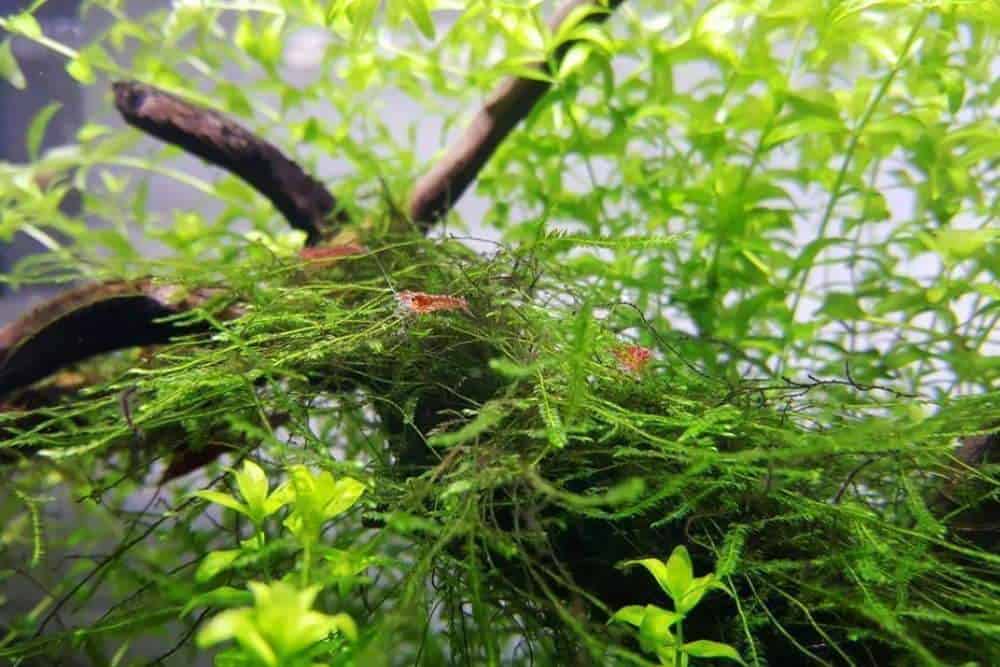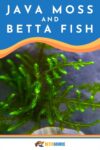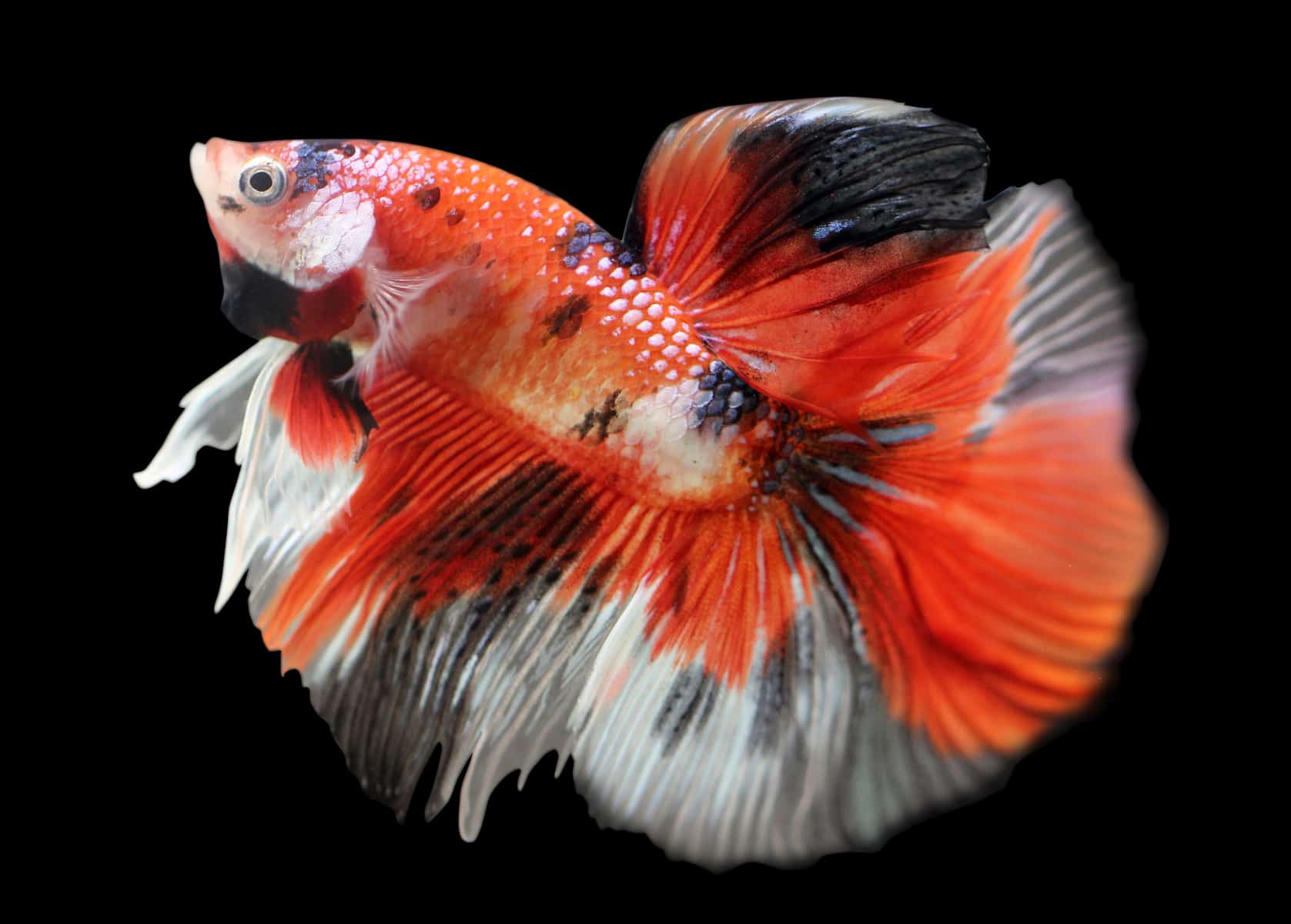It can be a little boring for both you and your fish to have an unplanted aquarium. Plants are a great addition to most aquarium setups and don’t require much extra maintenance in order to thrive. Java moss is one of the best plants to keep with betta fish and can be used in a variety of ways to make your fish feel more like it would in its natural environment and to help keep water conditions ideal.
Keep reading to found out everything you need to know about Java moss care as well as how Java moss can benefit your betta fish tank!
About Java moss
Though it is sometimes advised against to keep bettas with aquatic plants, Java moss tends to be the exception; while hobbyists seem to have had the most luck with their bettas not eating or picking at Java moss, each fish is different and there is no guarantee that you will be as lucky.
Note: Java moss is relatively inexpensive and will most likely bounce back to full health if transferred to a new tank after being nipped at by fish or invertebrates.
Name
Java moss is most commonly referred to as its previous scientific name of Vesicularia dubyana. However, the exact classification of Java moss is still up for debate, and it has gone by a few other names, including Isopterygium barbieri and most recently, Taxiphyllum barbieri. Java moss is part of the Bryophyta division, which means that these plants are true mosses that are directly related to terrestrial mosses!
Its common name, Java moss, is thought to derive from the areas in which the species was originally discovered.
Natural habitat
Java moss is widely native to Southeast Asia and possibly named after its prevalence in Java, Indonesia. These areas of tropical freshwater usually have moderate water flow. While mainly used in freshwater aquariums, it has also been observed in slightly brackish conditions.
Java moss will only grow in wet conditions, taking over rocks, trees, branches, and other debris. It may sometimes be seen growing out of the water in areas that regularly flood or are constantly subjected to other sources of wetness; if the moss is allowed to dry out for any amount of time, it will die.
Identification
Java moss can be a little difficult to identify as it tends to resemble other aquatic mosses; one of the most common mix-ups is misidentifying Java moss (Vesicularia dubyana) as Christmas moss (Vesicularia montagnei).
When buying Java moss, it is always best to try to go to an aquarium shop that has scientific names listed with the plant. If that is not possible, then you will need to look a bit closer to see the difference!
Java moss is a brilliant and vibrant green plant that usually grows in dense mats over substrates, driftwood, and other aquarium decorations. It tends to grow in long strands that have a fuzzy texture. Christmas moss will have even fuzzier stands, and will actually look like a fir tree with the fuzziness increasing towards the bottom.
Java moss tank requirements
This plant is incredibly easy to keep and nearly impossible to kill, making it a perfect starter species for beginner hobbyists.
Java moss is a tropical plant and will need to be kept in an aquarium with a stable water temperature between 72-82° F (22.2-27.8° C). pH should also be consistent between 6.0-7.5. As these plants are incredibly hardy, they will most likely survive less-than-ideal conditions and sudden parameter swings. However, you should always make sure that your tank is cycled and testing how it should. If you’re just starting your betta tank, make sure to check out our quick and easy all-in-one setup guide.
Water flow is important for the health of Java moss. As this plant grows in dense mats, algae is very likely to grow in dead zones where debris is allowed to settle due to lack of flow. However, too strong of flow can also cause the Java moss to become uprooted. There is also a delicate balance in giving your plant too much light and not enough.
Java moss can be kept under most lights, from low light to high light. Low light intensity will cause the plant to be darker in color and less-loosely packed together. High light intensity will cause the plant to be lighter and more compact. It is recommended to keep Java moss under moderate to high lighting for the best growth results. However, higher light intensities can also lead to more algae.
If you find that your Java moss starts growing algae, you may lightly scrub the plant with a toothbrush, remove the affected pieces, or use an aquarium-safe product that helps eliminate algae. You can also try adjusting light periods and intensities as well as water flow.
Planted betta fish tanks
There are many advantages to keeping live plants in your aquarium including nutrient export, shelter, and shade, as well as imitating natural surroundings. There are also a few disadvantages as well, like additional maintenance and the possibility of hitchhikers.
Here we will go over both the advantages and disadvantages of having Java moss in your planted betta tank:
Advantages
Nutrient export. One of the most attractive benefits of keeping live plants in your aquarium is nutrient export. Like terrestrial plants, aquatic plants need certain nutrients to survive, like nitrogen and phosphorus. In aquarium husbandry, most hobbyists struggle with maintaining and regulating nitrates and phosphates especially, which are usually the main culprits for algae growth.
Plants require both nitrates and phosphates to complete photosynthesis and ultimately grow. Since Java moss can grow at exceptionally fast rates, it is a preferred plant for nutrient export. While live plants are great at uptaking excess nutrients, they should never be used as a temporary solution; algae problems are usually caused by a combination of poor tank maintenance, overfeeding, and/or insufficient flow. Once the nutrients are removed from the water column, additional supplements may need to be made for the success of the plants and the overall tank.
Shelter and shade. Java moss can be grown practically wherever in the aquarium, creating dense mats along the substrate or left hanging on pieces of driftwood. Each clump of Java moss shelters the many little organisms in your tank and has its own mini-ecosystem inside of it. If attached to a higher area in the tank, the Java moss not only creates a refuge but also provides shade for organisms below.
If keeping your Java moss under higher lighting, then at some points, your betta might want some shade. Using Java moss to create a canopy can be a good way to bring pockets of shade into the aquarium for both your fish and possibly other plants that grow best in low light.
Natural surroundings. Much tropical fish come from rich ecosystems with thriving vegetation; some fish available at pet stores may even be wild-caught and could be coming directly from those ecosystems into your tank. Live plants are as much of the ecosystem in your tank as your fish are.
Plants can be a great addition to a betta fish tank as most times bettas are kept by themselves and can get bored. Not only will the plants fill up the empty space, but they will also give a glimpse into the real environments that your fish came from and provide additional enrichment.
Disadvantages
Additional maintenance. Like we’ve mentioned, Java moss can grow extremely fast and in a wide range of parameters. This means that if your tank is thriving, your Java moss is probably thriving too much and you will find yourself having to need to trim your plant more often than you would like.
There is also the possibility that your Java moss plant will grow algae, which can lead to algae problems for the whole tank. As long as there is enough flow, moderate lighting, an appropriate photoperiod, good filtration, and good tank husbandry, algae problems should be relatively easy to fix, though still frustrating if they occur.
Some hobbyists have had difficulties with their Java moss clogging up and damaging aquarium equipment, like powerheads and filters. The best way to keep this from happening is by making sure that your Java moss is securely attached to whatever you are attempting to grow it on.
When taking home Java moss, more than likely you will be given a tuft that is not attached or secured to anything. In order to make the Java moss stick to a piece of driftwood or other aquarium decoration, it is recommended to use a fishing line or thread. The fishing line/thread trick will keep your Java moss in your desired location without having it drift away and getting in your equipment.
Hitchhikers. As with any live aquatic plant, Java moss has the possibility to introduce hitchhikers into your tank, most commonly snails. Though there are a few ways to prevent them from entering your tank, like bleach dips or quarantine, there is, unfortunately, no method that is completely risk-free.
Still, hitchhikers should not deter you from trying to grow plants in your tank! Even if hitchhikers do enter your system, there are ways to treat and eradicate the problem otherwise.
Keeping java moss with betta fish
So what makes Java moss one of the best plants for betta fish? For some reason, Java moss is one of the few plants that bettas seem to completely ignore. Here are a few questions you might find yourself asking before you try to grow Java moss in your betta tank:
Is Java moss good for bettas?
Yes! Plants, fish, and invertebrates work together to support an ecosystem where each organism has its own niche where it survives. As we mentioned before, Java moss uptakes nutrients from the water column. But where do those nutrients come from? In a closed system like a fish tank, those nutrients will mainly come from your betta fish!
Like other fish, betta fish expel waste which then feeds bacteria in your tank, allowing for the nitrogen cycle to take place. At the same time, your Java moss will uptake that nitrogen whenever it is in an acceptable form, like nitrite or nitrate; atmospheric nitrogen may also be converted in this process. Betta fish will also provide the carbon dioxide needed for your Java moss to undergo photosynthesis, while your Java moss will provide your betta with dissolved oxygen to breathe.
On top of direct waste from your betta, leftover food will be left to decompose and will breakdown, releasing any nutrients that were part of the ingredients. A lot of these foods release phosphate which can quickly lead to algae outbreaks when left in excess. Luckily, Java moss loves phosphates and will help quickly uptake nutrients before algae can on most occasions!
On top of being a nutrient export, Java moss provides your betta with a natural environment while providing shelter and shade.
Does Java moss oxygenate the aquarium?
Like any other plant, Java moss performs photosynthesis. This is when plants use carbon dioxide, water, and light to produce sugar and oxygen; the sugar is the food they need to grow and survive, while the oxygen is a byproduct of the process.
Since Java moss is an aquatic plant, the oxygen that is released is described as dissolved oxygen, or how much oxygen is actually present in the water. Normally, dissolved oxygen is entered into the water column by way of surface agitation and gas exchange. But with a planted aquarium, your water will be even more oxygenated due to your Java moss undergoing photosynthesis and releasing oxygen directly into the water column!
How do I maintain Java moss?
One of the bad things about Java moss is that it can grow very fast and very quickly; once it starts growing, it will continue growing. Luckily, Java moss is very easy to control with aquarium-safe scissors; make sure that they don’t rust!
When pruning/trimming your Java moss, you will want to turn off all filters, powerheads, and any other equipment that circulates the water. It is recommended to have a tweezer and fishnet on standby as small strands of moss tend to become free-floating and disappear to the back of the tank; a new colony of Java moss can grow from a very small patch, which can lead to having moss in places that you don’t want!
The trimmings can then be discarded, replanted, given to another hobbyist, or tucked underneath the main plant to make it grow denser. It is pretty hard to kill Java moss, so feel free to trim/prune as much as you want so long as the remaining patches are still intact.
Conclusion
Java moss is one of the best plants to keep with betta fish as it is one of the few species that they tend to ignore. Java moss can benefit your betta in several ways, including acting as a nutrient export, providing shelter and shade for your betta, and replicating natural betta environments. Java moss grows very quickly and will need to be trimmed regularly, but extra pieces can be used for a fish fry, replanting, or given to another hobbyist.
Remember, when buying live plants, there is always the possibility that hitchhikers will enter your system. Also, be prepared to have to keep your Java moss from clogging up your filter and other aquarium equipment.
If you have any questions about keeping Java moss with betta fish, make sure to leave a comment below!











